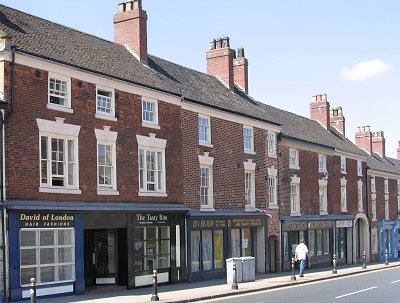|

Listing: each property is listed as mid to late C18, part of a
surviving C18 row.
Comment: This row has been the subject of a large and successful
restoration project. If you showed this photo to most Wulfrunians they would
have to think at least twice to say where it is - it is as if a splendid
Georgian row has appeared from nowhere. This side of Snow Hill probably never
looked so good before - maybe even when it was new.
This was originally a row of three storey town houses, built probably in the
1750s, at about the same time as St. John's, nearby.
They were probably all built at much the same time and, possibly, by the same
builder or developer. They were first occupied by better off manufacturers
but were taken over by professional people. They then started to slide
downwards with the land at the back being developed by extensions and even two
courts: these parts were occupied by much lower classes and industrial
uses. The ground floors were converted to shops. During the 20th
century things seem to have got worse and worse: where alterations were made
they were badly and unsafely done - walls were removed and the upper floors
supported by spindly and inadequate rsjs, chimney breasts were removed on one
floor leaving the chimney brickwork on the upper floors resting on floorboards;
and there was a general lack of maintenance leading to extensive penetration by
water and pigeons, wet and dry rot, etc.. By 1996 only two shops were
occupied and the position of the whole row seemed hopeless.
The Council then got in touch with the Buildings at Risk Trust, one of whose
main aims is to get funds to restore historic buildings the restoration of which
would not be viable for the ordinary developer. The Trust and the Council
raised funds from anywhere and everywhere. Bromford Housing Association
joined in, agreeing to take over flats to be created on the upper floors.
BART bought the premises for a very small sum. Eric Hudson, a local
architect, (who had restored Fred Williams' cycle shop further down Snow Hill
and has now done other highly regarded and awarded winning work on
7 Summerfield Road) was brought in and eventually drew up all the proposals
and plans, working closely with the Council's conservation officers. The
scheme was originally for 28 - 33 Snow Hill but 34, 35 and 36 were added to the
scheme later (causing some delay in completion).
Most of the accreted buildings at the rear were in appalling
condition and had to be removed, reducing the site to the original row.
Nearly all internal details had gone. When work started, in 1998,
the condition of the buildings was found to be even worse than the
initial survey had indicated. Even the original construction had
been poor with walls not tied in. Numbers 34 and 35, when bought
for a nominal sum, were found to be utterly beyond repair and had to be
demolished. All the cellars had houses but these had to be filled in to
avoid increasing the problems.
The scheme of restoration was to restore the front part of the row as
shops with flats over, adapting the back to suit these ends. The
late 19th century shop fronts have, where possible, been kept; an arched
carriageway entrance has been glazed on both sides with access from one
of the new shops, thereby preserving the views through whilst making an
attractive display area. The windows are part original and part
reproductions, provided with secondary glazing in order to maintain a
better and more original appearance than double glazing would have
allowed. No.34 and 35 are reconstructions, using only a few
available pieces of the original buildings; since the originals were
rendered, as is the reconstruction, the old appearance and the unity of
the row are preserved. At the rear something of the
higgledy-piggledy nature of the later accretions has been preserved in a
varied and interesting facade, though the landscaping seems rather
sparse. The number, size, design and layout of the flats was not
committed to at an early stage and the architect was able to arrange
whatever flats grew naturally out of the restored buildings. This
has resulted in very attractive flats, including an unusual one bedroom
flat on three floors - the structure it inhabits having been built
primarily to act as a buttress for the original buildings. The standard
of work throughout is very high.
The work was eventually finished in September 2000 and the whole
result was officially opened by Lord Montague of Beaulieu on 29th
September 2000.
The work has provided a refurbished and attractive row of shops;
and a number of highly desirable, town centre, one and two bedroom flats
and one 3 bedroom flat, which overlook some interesting buildings on
Snow Hill or, at the back, the Convent and Chapel complex at the
foot of George Street. Not surprisingly they were let immediately.
Its contribution to this entrance to the town is enormous. And it
now forms part of an excellent Georgian walk - up Snow Hill, down George
Street, round St. John's in the Square and down Bond Street.
One suspects that, if the difficulties and expense had been known
before work began, work would not have begun; one just has to be glad
that some secrets remained hidden for long enough and that those
concerned stuck to their guns.

|